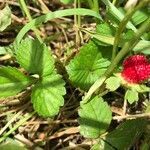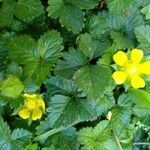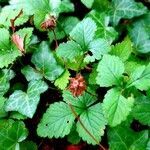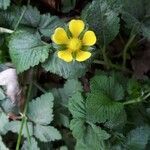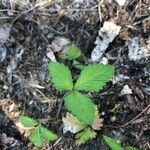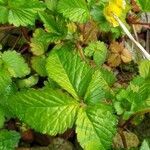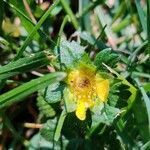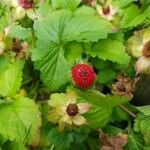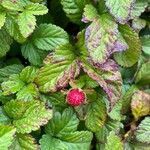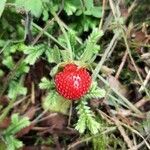Rosette herbs with long, prostrate, partly sym-podial stems (stolons) bearing leaves and flowers and also reduced leaves, daughter plants produced on the nodes bearing reduced leaves. Stems, pedicels and petioles with long, ± patent hairs and usually many multicellular glandular hairs. Leaves trifoliolate, petiole up to 12(-16) cm. Stipules membranous, c. 1 cm long, long-hairy outside. Leaflets sessile or shortly petioluled, apical leaflets rhomboid to obovate, 1.5-3.5 by 1-2.5 cm, base cu-neate, apex rounded, serrate in upper part, lateral leaflets elliptic to ovate, slighdy smaller and usually with unequal base, all leaflets long hairy below and on the nerves also with glandular hairs. Flowers solitary, seemingly placed opposite the runner-leaves, rarely 6-merous, pedicels 2-8 cm long. Hypanthium 2-3.5 mm diam., sparsely hairy outside* Epicalyx leaves ± obovate, 3-5 by 2-3 mm during anthesis, distinctiy growing afterwards, with 2-6 incisions in the apical part, sparsely hairy outside. Sepals narrowly triangular, 4-6 by 2-3 mm during anthesis, indumentum outside as epicalyx. Petals obovate, 3.5-4.5 by 2-3.5 mm, yellow. Stamens 15-20, filaments up to 2.5 mm, anthers c. 0.5 mm. Torus elevated, hairy or glabrous, distincdy enlarging after anthesis. Pistils many, sessile, ovary glabrous, style inserted laterally above the middle and in anthesis much longer than the ovary. Collective fruit 5-11 mm diam, soft and fleshy, red. Achenes 0.9-1.3 by 0.7-1 mm, red to brownish, smooth or distincdy rugose to tuberculate.
More
Perennial herb, 0.05-0.20 m high; stems short, leaves in rosettes and on long runners rooting at nodes and tips to form a new rosette. Leaves with 3 leaflets, hairy, leaflets obovate to angular-ovate, margins coarsely toothed, terminal leaflet 10-30 x 7-25 mm, lateral leaflets slightly smaller. Flowers: stalks 25-100 mm, slightly longer than subtending leaves; episepals and sepals hairy, persistent in fruit; petals bright yellow. Flowering time Apr.-June. Fruit a false fruit or pseudocarp, achenes embedded along the surface of a bright red, swollen receptacle, up to 20 mm in diam., insipid to taste.
A creeping herb. The leaves have stalks. They are alternate. There are leafy structures at the base of the leaf stalk. The leaves have 3 leaflets. The leaflets do not have stalks. They are 1-2.5 cm long by 1-1.8 cm wide. They have teeth and are hairy. The middle leaflet is larger than the others. The flowers have stalks. The flowers are yellow and occur singly. The fruit is round, red and succulent.
Perennial herb with epigeal, rooting stolons. Epicalyx segments 3-toothed at apex. Leaves 3-foliolate, rather long-petiolate, leaflets obovate, crenate. Flowers solitary. Flowers yellow.
Uses Perry & Metzger ( Perry & Metzger Medicinal plants of E and SE Asia 1980 342 ) report many medicinal uses from China, especially for burns, bites, boils, etc. The fruits are almost tasteless but edible; they are, however, reported to be poisonous when too many are eaten.
More
The ripe fruit can be eaten raw. They are watery and with little flavour.
